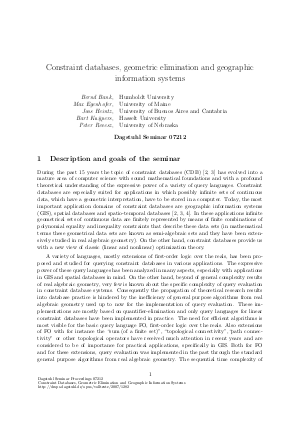07212 Manifesto – Constraint Databases, Geometric Elimination ang Geographic Information Systems
Authors Bernd Bank, Max J. Egenhofer, Joos Heintz, Bart Kuijpers, Peter Revesz
-
Part of:
Volume:
Dagstuhl Seminar Proceedings, Volume 7212
Part of: Series: Dagstuhl Seminar Proceedings (DagSemProc) - License:
 Creative Commons Attribution 4.0 International license
Creative Commons Attribution 4.0 International license
- Publication Date: 2007-12-17
File

PDF
DagSemProc.07212.2.pdf
- Filesize: 130 kB
- 7 pages
Document Identifiers
Subject Classification
Keywords
- Constraint databases
- elimination procedures
- geographical information systems
Metrics
- Access Statistics
-
Total Accesses (updated on a weekly basis)
0PDF Downloads0Metadata Views
Abstract
During the last two decades the topic of constraint databases has evolved into a mature area of computer science with sound mathematical foundations and with a profound theoretical understanding of the expressive power of a variety of query languages. Constraint databases are especially suited for applications in which possibly infinite sets of continuous data, that have a geometric interpretation, need to be stored in a computer. Today, the most important application domains of constraint databases are geographic information systems (GIS), spatial databases and spatio-temporal databases. In these applications infinite geometrical sets of continuous data are finitely represented by means of finite combinations of polynomial equality and inequality constraints that describe these data sets (in mathematical terms these geometrical data sets are known as semi-algebraic sets and they have been extensively studied in real algebraic geometry). On the other hand, constraint databases provide us with a new view on classic (linear and nonlinear) optimization theory.
Cite As Get BibTex
Bernd Bank, Max J. Egenhofer, Joos Heintz, Bart Kuijpers, and Peter Revesz. 07212 Manifesto – Constraint Databases, Geometric Elimination ang Geographic Information Systems. In Constraint Databases, Geometric Elimination and Geographic Information Systems. Dagstuhl Seminar Proceedings, Volume 7212, pp. 1-7, Schloss Dagstuhl – Leibniz-Zentrum für Informatik (2007)
https://doi.org/10.4230/DagSemProc.07212.2
BibTex
@InProceedings{bank_et_al:DagSemProc.07212.2,
author = {Bank, Bernd and Egenhofer, Max J. and Heintz, Joos and Kuijpers, Bart and Revesz, Peter},
title = {{07212 Manifesto – Constraint Databases, Geometric Elimination ang Geographic Information Systems}},
booktitle = {Constraint Databases, Geometric Elimination and Geographic Information Systems},
pages = {1--7},
series = {Dagstuhl Seminar Proceedings (DagSemProc)},
ISSN = {1862-4405},
year = {2007},
volume = {7212},
editor = {Bernd Bank and Max J. Egenhofer and Bart Kuijpers},
publisher = {Schloss Dagstuhl -- Leibniz-Zentrum f{\"u}r Informatik},
address = {Dagstuhl, Germany},
URL = {https://drops.dagstuhl.de/entities/document/10.4230/DagSemProc.07212.2},
URN = {urn:nbn:de:0030-drops-12824},
doi = {10.4230/DagSemProc.07212.2},
annote = {Keywords: Constraint databases, elimination procedures, geographical information systems}
}
